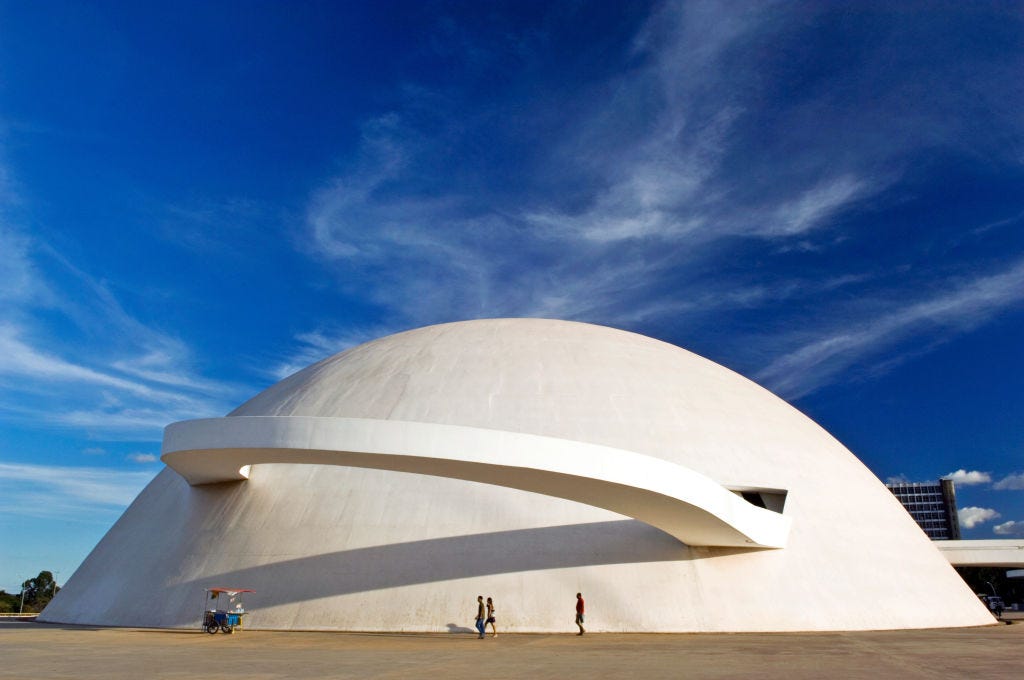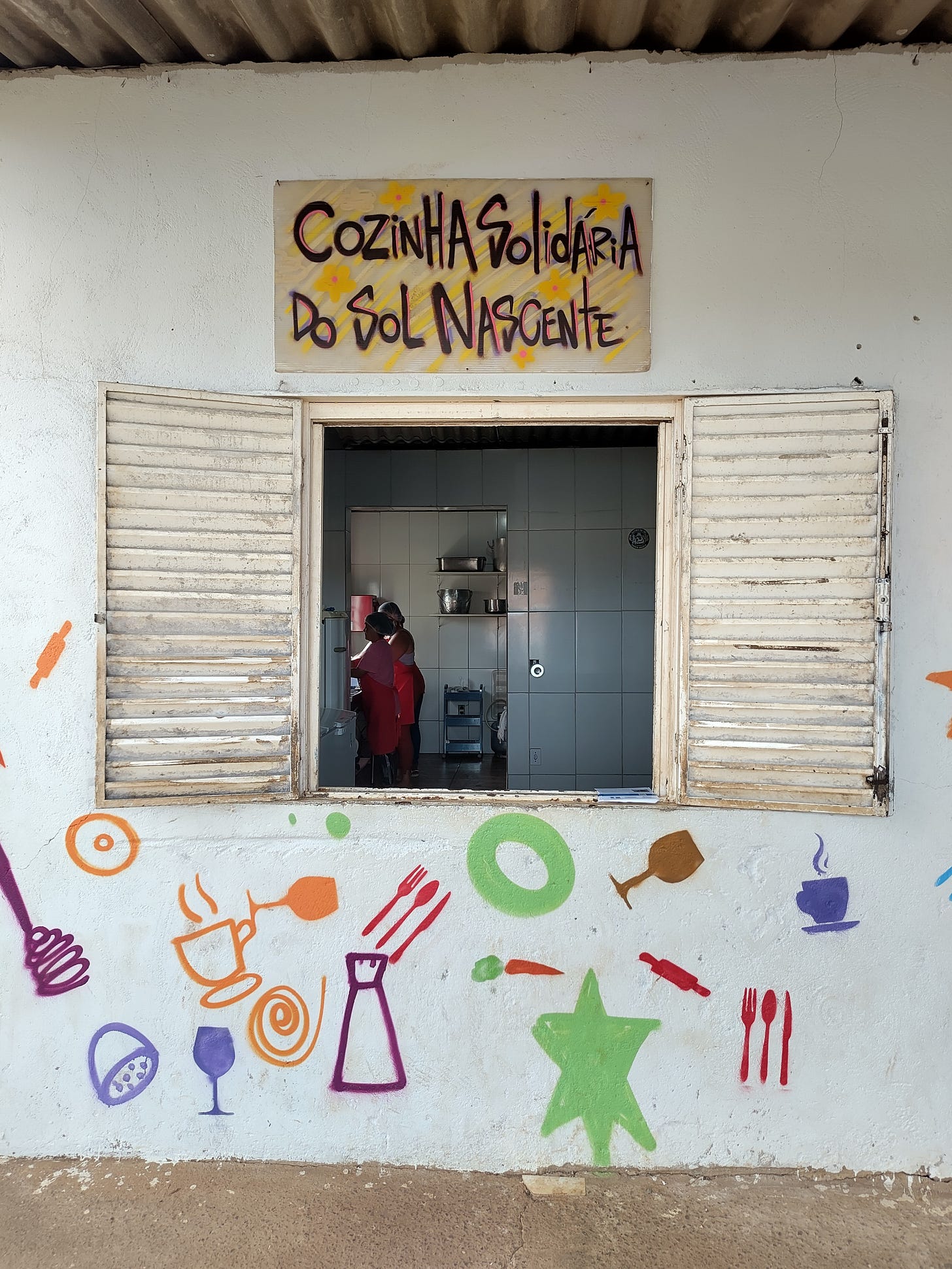Notes From Brasilia
Reflections on the state of food systems
I’m in Brasilia this week, emceeing a three-day conference on “Overcoming Barriers to Food Systems Transformation” and also moderating two plenary sessions. The discussions were candid, thought-provoking and tangible, a rare combination.
It also means I am quite shattered. Sitting and absorbing information at a conference can be exhausting, but having to be present all the time, listening actively and responding appropriately, takes that to another level.
The above is a long-winded way of me saying this issue is gonna be a short one. But I also learnt a ton and wanted to share some initial reflections and takeaways. I hope you find them interesting too.
I landed in Brasilia at 1:30 in the morning, which wasn’t the best time to get a proper first impression.
In the haze of sleepiness - to acclimatise my body to the new time zone, I stayed awake during the 12+ hours flight - all I noticed was how wide and empty the roads were. I also discovered most of the hotels are in one area and government buildings in another.
Anyone who’s ever been to Naypyitaw would know where I’m going with this. Myanmar’s preposterous new capital was built in the country’s interior (some say, in the middle of nowhere) and has 20-lane highways that are big and mostly deserted, and designated zones for hotels and government buildings.
Brazil’s capital city is also purposely built - apparently in the shape of a bird or a plane - and on the country’s central plateau but this is where the similarities end, as I realised the next morning when I saw the city in bright daylight.
While Myanmar’s new capital was built by paranoid military dictators who wanted to sequester themselves in a hard-to-reach area as a defence mechanism, the idea of Brasilia - or at least a capital in the interior - has been around since the late 18th century, even if it wasn’t fully realised till 1960.
I found the architecture in the central planned city unique, captivating, and quite dream-like, unlike the uninspiring concrete blocks in Naypyitaw. I also cannot imagine Naypyitaw ever getting on the list of the UNESCO World Heritage Sites, like Brasilia did in 1987.
Besides, during rush hour, traffic jams are a common sight, including in one of the city’s main thoroughfares, a six-lane highway going in one way.
Of course, not all is well. Outside the planned centre with its wide boulevards is a sprawling periphery where mostly low-income communities live. In these satellite cities, the infrastructure, services, and green spaces are few and far between, as I learnt during a short field trip on Wednesday.
The Event
The conference was organised by the Sustainable Food Systems Programme of One Planet Network (OPN). OPN is all about sustainable consumption and production, and is comprised of experts, policymakers and practitioners from governments, businesses, civil society, academia and international organisations including the United Nations.
There are thousands of individual members and six thematic programmes that include Sustainable Buildings and Construction, Sustainable Food Systems, and Sustainable Tourism. The Sustainable Food Systems Programme’s vision is of food systems that are inclusive, diverse, resilient, healthy and sustainable.
It is co-led by the Ministry of Agriculture and Livestock of Costa Rica, the Federal Office of Agriculture of Switzerland, and the World Wide Fund for Nature (WWF)
The Takeaways
The Triple Monotony
This is the term Professor Arilson Favareto, the conference’s first keynote speaker and Josué de Castro Chair of Healthy and Sustainable Food Systems at the University of São Paulo, used to describe the basis of the current global agrifood system.
Agricultural monotony: The Green Revolution’s emphasis on the efficiency of seed selection and seed modification has led to increased use in pesticides and fertilisers which “promotes the vulnerability of these very monotonous landscapes”. At the same time, the market is dominated by a few large corporations that force farmers to use their products.
Livestock production monotony: 30% of grain production is dedicated to animal feed, but if pasture land for animal feed is taken into account, it becomes 70%. Again, poultry and cattle production are controlled by big companies.
Food monotony: 75% of calories today come from six crops. Ultraprocessed foods based on industrial recipes and formulations which “offer an artificial diversity of colours and flavours but are based on corn, soy, sugarcane, and the reduction of food variations and diversity”. This is a major factor in increased obesity and noncommunicable diseases.
You can watch this part of his speech here. He also laid out five things to do to move away from this monotony.
Less tech solutions, more good governance, please!
The second keynote speaker, Chris Béné, focused on the policy economy of food systems. Chris, Senior Policy Advisor and Principal Scientist at the Alliance of Bioversity International and the International Centre for Tropical Agriculture (CIAT), cited general literature’s view that transformation is a political process.
“When applied to food system transformation, it means that, contrary to maybe what a lot of people want us to believe, the transformation of food systems does not depend on technology. It depends essentially on governance and politics,” he said.
He gave specific examples of specific political economy dynamics. His whole presentation is worth watching.
Food is Politics
There’s the old adage of not talking politics at dinner but in many countries, being able to eat - and eat well - itself is political.
For example, Yessika Hoyos of Colombia-based lawyers’ collective CAJAR, made a compelling point that if unhealthy diets and food are causing untimely deaths or health problems, then the people’s fundamental right to health and food are being affected. Thus, the manufacturers of these products should be held accountable.
Again, her whole presentation is worth watching.
The intricate connection between food and politics was in full view on Wednesday, when a group of us visited a community solidarity kitchen in Sol Nascente, an administrative region on the outskirts of Brasilia with little of the latter’s striking architecture but much of the poverty that is invisible there.
News reports said preliminary government data from 2022 showed Sol Nascente (which means Rising Sun in English) has become the largest favela (or) low-income neighbourhood in Brazil, surpassing Rocinha, in Rio de Janeiro, in number of households. Here’s a 2023 AP article about it.
The community solidarity kitchen was an initiative borne out of the COVID-19 pandemic to support struggling families, during the destructive reign of the far-right president, Jair Bolsanaro.
“People were going hungry and they weren’t getting support from the state. The state wasn’t working with us, it was working for the rich people,” said Euardo, who oversees the kitchen, which distributes about 120 meals a day.
They now received state support in the form of regular food donations, as part of a new, year-old anti-hunger initiative by the Lula government (see more below). The kitchen has a garden at the back and is also a civic space that holds regular discussions about politics.
“Our struggle is against the capitalism and the extreme right. We are part of a great political debate to bring people together and empower each other.”
Procurement, Procurement, Procurement
Before the establishment of the community kitchen, families used to have to weigh paying rent and paying for food, said Eduardo.
So the government’s decision to support the kitchen by buying fresh produce from small-scale family farmers who practice nature-friendly farming methods including agroecology, was a real help, he said.
This way, hungry families get a hot meal and local farmers get competitive prices.
The most obvious and cited example of public procurement in Brazil is the school meals program, officially known as the National School Feeding Program (PNAE), mandated by Law No. 11.947/2009.
This law requires that at least 30% of federal funds allocated for school meals be used to purchase food directly from local family farmers, bypassing the traditional bidding processes. Research has shown this supports smallholders, improves the nutritional quality of school meals by increasing the variety and quantity, and reduces the presence of ultra-processed foods. It’s not perfect but it’s still a damn impressive programme.
The law may sound straightforward, but it requires a lot of intentionality and detailed planning at multiple levels, including determining who is a family farmer and how they farm, and developing a framework to support their work.
Imagine if all governments and profit-driven companies around the world were to do the same: requiring contractors feeding patients, office workers, university students, prisoners, military bases, etc. to source their produce from local farmers who grow their food in a way that’s better for nature, human health, and social justice?
It isn’t a silver bullet - someone said public procurement is only a drop in the ocean when it comes to the value of food systems - but it can still be a powerful driver.
Transformation is everywhere
Elisabetta Recine, former president of the National Food and Nutrition Security Council (CONSEA) of Brazil and member of IPES-Food, recounted how civil society pushed the government to implement public policies and programmes that have transformed the lives of ordinary Brazilians.
She cited food procurement (see above), cistern, and school meal programmes as examples, but warned of the challenges of maintaining them. She also said something beautiful about our own role in the process. Her full comments are here.
“Our politicians need to be the instruments of transformation. But transformation happens here. Transformation happens in the cities, in the villages, in the communities, in the indigenous communities, in the fields… and, you know, in the peripheries of the urban centers.”
In an earlier discussion in the same plenary session, she also said, “All this process of transformation requires what we would call a democracy, but not just in its formality of institutional spaces, but it's the democracy of all sectors and segments of the all the micro societies within a country.”
Thin’s Pickings
Grocery Update Volume 2, #4: MAHA Or Misdirection. - The Checkout
Errol Schweizer’s deep dive into the MAHA report, including the contradictions, and his own thoughts on how to make America healthy again is all you’ll need to read this weekend.
As always, please feel free to share this post and send tips and thoughts on bluesky @thinink.bsky.social, mastodon @ThinInk@journa.host, my LinkedIn page, twitter @thinink, or via e-mail thin@thin-ink.net.






A much needed post, I’m glad to be able to “be there” through your eyes (and words)!
Thank you Thin. Very accurate and very nice to read reporting!